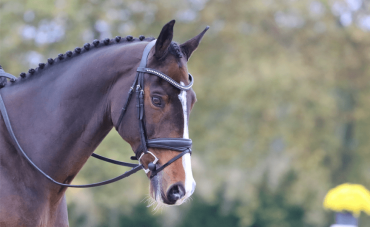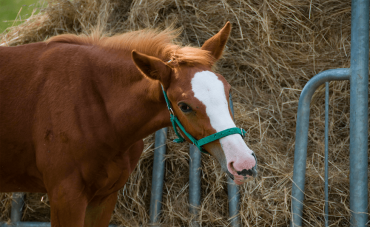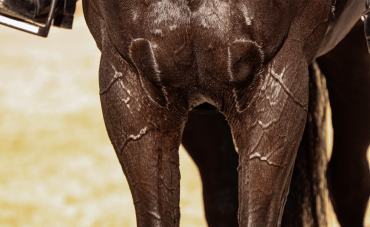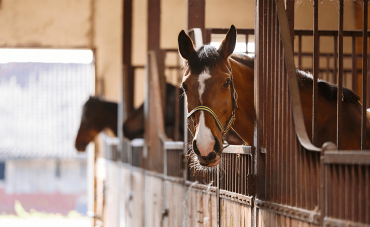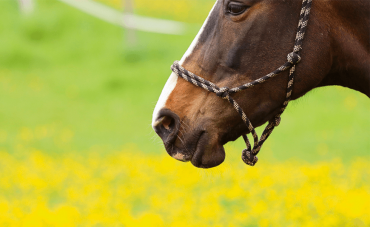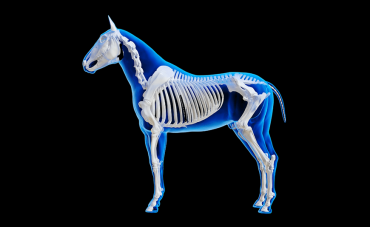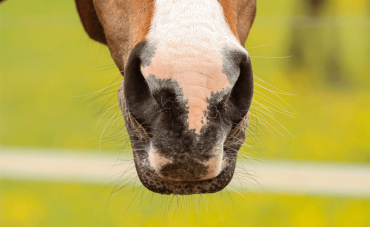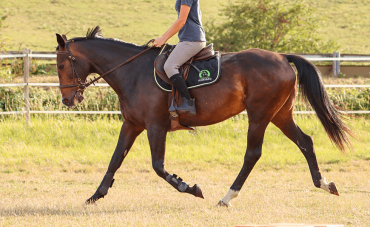Limping is an issue that can strike suddenly without warning. Your horse may appear perfectly sound one day and then, during a session, exhibit stiffness and lameness. As a rider, it's not always easy to pinpoint the problem, but the crucial point is that your horse is indeed limping. Even if the lameness seems mild, swift action is necessary to prevent any further deterioration of the situation. Here are some guidelines on what to do when your horse is limping.
Why is my horse lame?
The term limping (or lameness) is a symptom that can be caused by various underlying conditions, ranging from slight stiffness to an inability to bear weight on a limb. Regardless of the nature of the lameness, it is essential to identify the root cause.
To diagnose the source of lameness, it's crucial to conduct a thorough examination of your horse, not just its limbs. Sometimes, visual cues can help you pinpoint the problem. Look for wounds, swelling, or areas that are warmer than usual. Most instances of lameness originate in the lower part of a limb, such as the foot or fetlock. Start by examining the limbs, but bear in mind that issues with the back can also be the root cause. Finally, don't forget to pick your horse's feet, this will allow you to check if they are hot or not but also to make sure that there are no stones or nails stuck in them. Remember that if it is a foot abscess, it may not be visible as it develops inside the foot.
Additionally, it's important to identify which limb(s) are affected, which may not always be apparent. If your horse is not placing weight on a particular limb, you can easily identify the "sick" limb. However, if the lameness is subtler, having a second person observe your horse walking and trotting in a straight line can help determine the affected limb.
Although identifying lameness may sound straightforward in theory, it can be more challenging in practice. Here are some tips to aid in the process:
- If your horse has a lame foreleg, it may "drop" its head when placing the healthy limb down. This means that if your horse "falls to the left," it is experiencing lameness in its right front leg.
- If your horse has a lame hind leg, stand beside it and observe which hind leg is least forward. This will usually be the one that is responsible for the lameness.
What should I do if my horse is lame?
Once you have a clearer understanding of the cause of your horse's lameness, it is essential to contact your veterinarian. However, the speed of the vet's response will depend on the cause and type of lameness. After examining your horse, your vet can assess whether it is an emergency.
Certain situations are considered urgent:
- Your horse's body temperature is abnormal (> 38.3°C at rest or < 36°C).
- Your horse has an open wound that is bleeding significantly, or a limb that is enlarged, swollen, and warm.
- Your horse displays a significant joint (or tendon) deformity accompanied by heat.
- Your horse has a nail embedded in its hoof, which should not be removed until the vet arrives.
- Your horse has severe difficulty moving and refuses to do so.
- Your horse is unable to bear weight on a limb.
If your horse falls into any of these categories (even without obvious lameness), it is imperative to contact your vet urgently.
Whether or not the lameness requires urgent veterinary intervention, there are precautions you can take:
- If your horse is willing to move, return it to the stall or place it in a small paddock. This prevents the lameness from worsening while awaiting the vet's arrival.
- You can cool your horse's limbs by rinsing them with cold water. However, refrain from using clays, as they may not provide significant benefits and can interfere with the vet's diagnosis.
- Avoid taking the initiative to administer anti-inflammatory drugs to your horse without a veterinary examination. This can complicate the diagnosis and, if misused, potentially worsen the issue. For example, giving a painkiller to a horse with tendonitis may lead to additional strain on the affected limb.
The different types of lameness and their treatment
Once your vet has assessed the cause of the lameness, they will tailor the treatment and preventative measures accordingly. Here are some common causes of lameness and their respective treatments:
Abscess-related lameness:
This form of lameness is often associated with a foreign body's penetration into the foot, leading to an abscess. Typically, there is no sign of the object until the horse suddenly begins to limp, with varying degrees of severity depending on its pain tolerance. Until the abscess ruptures, applying a poultice can be helpful in maturing it. There are various methods for facilitating the passage of an abscess, so consult your vet for guidance. Your vet's intervention will help the abscess to drain. The release of pus, which is under pressure in the abscess cavity, will provide relief to your horse. Your vet will then apply a dressing to aid in pus drainage and protect the hole created by the abscess during healing. Abscesses, once healed, usually do not have long-term consequences. Some horses may develop recurrent foot abscesses when they have other associated conditions, such as laminitis or Cushing's syndrome.
Lameness due to tendon or ligament injuries:
Your horse's limbs contain numerous crucial tendons and ligaments, primarily situated on the front and back of the limb. These structures are critical for your horse's smooth movement during work and leisure. Because they are not well protected by other tissues, they are relatively exposed on the limbs. Lameness stemming from tendons and ligaments is not uncommon and varies based on the location and type of structure affected. These injuries can significantly impact your horse's mobility and, more importantly, their future in sporting activities. Various types of tendon injuries exist, such as tendinitis (inflammation of the tendon) and desmitis (inflammation of a ligament).
These conditions result from inflammation, partial or complete tendon rupture due to the horse's physical activity, or accidents following wounds. In some cases, the tendon may be severed due to trauma, and an infection can develop in the sheath where the tendon slides due to bacterial entry. This condition is known as septic tenosynovitis.
The choice of treatment depends on the nature and severity of the damage:
- Anti-inflammatory drugs, administered orally and/or by injection.
- Regenerative medicine via injections into the tendons.
- Local external care, including poultices, clay applications, showers, and local anti-inflammatory gels. The aim is to reduce inflammation and facilitate the drainage of edema and hematomas around and within the lesion.
- Occasionally, surgery may be required to clean the tendon, remove the hematoma and necrotic tissue, and expedite recovery. In cases of tendon or ligament injury resulting from a wound and bacterial infection, treatment may involve antibiotics, anti-inflammatory drugs, surgery to wash out the tendon sheath and remove bacteria, and dressings to protect the wound.
To find out more, see our article on tendinitis.
Lameness related to osteoarthritis:
Osteoarthritis is a degenerative joint condition characterised by the reduction of joint mass in your horse. This condition results from normal joint wear and tear due to aging or excessive joint wear and tear from overwork. Lameness in osteoarthritis is caused by joint pain, structural changes stemming from cartilage breakdown, and bone remodeling.
While osteoarthritis cannot be cured, veterinarians can offer treatments to slow its progression, including:
- Local treatments to alleviate pain in the affected joint, such as injections with various substances like corticoids, hyaluronic acid, irap, prp, and stem cells.
- Systemic treatments to relieve the affected joint and others, involving anti-inflammatory drugs to alleviate pain or bisphosphonates to target bone remodeling.
Early diagnosis is critical in cases of osteoarthritis to adjust the horse's environment and work routine, ensuring they maintain a certain level of physical activity.
To find out more, read our article on osteoarthritis.
Lameness due to laminitis:
Laminitis is inflammation of the lamina. In a normal horse, most of the body weight is carried by the front legs. In horses with laminitis, the body weight shifts backward to relieve the painful front legs, which are often most affected. Laminitis typically results in severe lameness, making it difficult for the horse to move. Swift diagnosis and treatment are crucial to prevent the complete rotation of the third phalanx and reduce long-term damage. The primary goal of treatment is to alleviate pain.
Your vet will often recommend non-steroidal anti-inflammatory drugs for maximum pain relief and inflammation reduction. Adjusting the horse's living environment, such as proper trimming or shoeing, is usually necessary. Weight loss is essential for horses prone to obesity. Laminitis is increasingly associated with hormonal disorders such as Cushing's disease, and managing these conditions through specific treatments can mitigate the risk.
Lameness related to navicular syndrome:
Navicular syndrome usually involves chronic lameness caused by pain originating from the navicular bone and surrounding structures. Horses usually develop this lameness between the ages of 7 and 9, though there can be variations. Common signs include short strides and increased lameness on hard ground. Like osteoarthritis, there is no cure for navicular syndrome. Management strategies include corrective trimming and/or orthopedic shoeing. Your vet may also suggest medications based on the disease's stage. Non-steroidal anti-inflammatory drugs can help alleviate pain, and the use of bisphosphonates can help manage affected horses.
In this overview, we've covered the main causes of lameness and what you can do about them. Lameness can also result from other issues, such as back problems, fractures, cracks, or neurological problems, but we've focused on the most common causes in this guide. Always consult your veterinarian for advice when your horse experiences movement issues.

